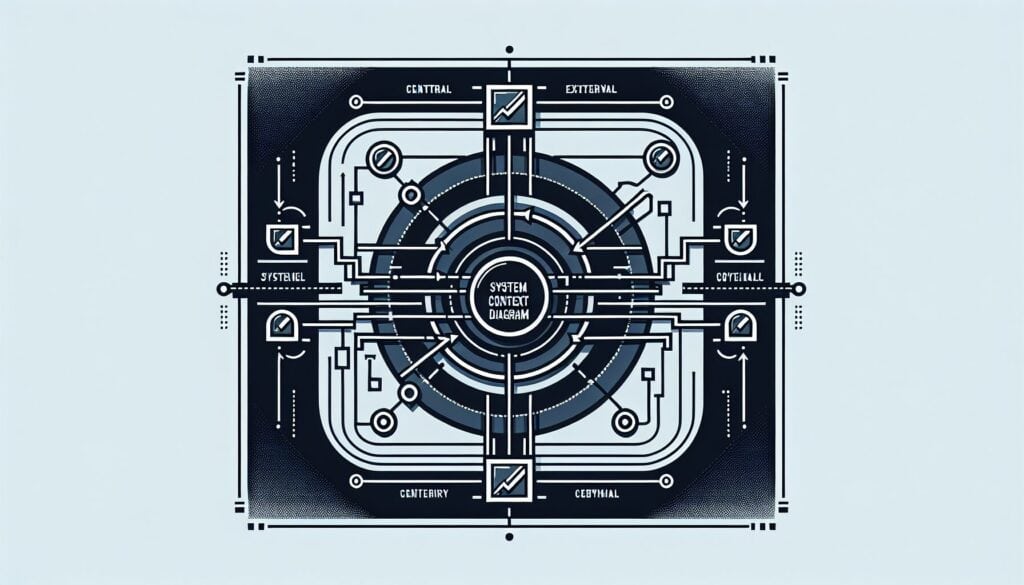To define the boundary between a system and its environment, showing the entities that interact with it.
- المنهجيات: الهندسة, الجودة
System Context Diagram

System Context Diagram
- المنهجية الرشيقة, تخطيط العمليات, إدارة المشاريع, إدارة الجودة, تصميم النظام, تجربة المستخدم (UX), واجهة المستخدم (UI), تصميم يركز على المستخدم
الهدف:
كيفية استخدامه:
- A high-level diagram that shows the system as a single process along with its inputs and outputs from/to external entities (e.g., users, other systems). It sets the scope of what is to be included in the system.
الايجابيات
- Simple and easy to understand, even for non-technical stakeholders; Clearly defines system scope and boundaries; Helps in identifying all external interfaces and stakeholders.
سلبيات
- Provides a very high-level view and lacks detail about internal system workings; Can be too simplistic for complex systems; May not capture all nuances of system interactions.
الفئات:
- العملاء والتسويق, الهندسة, تصميم المنتج, إدارة المشاريع
الأفضل لـ
- Establishing the scope of a system and identifying its external interactions and interfaces early in a project.
System Context Diagrams are widely utilized in various sectors including software development, engineering, and product management as a means to clarify the interactions between a system and its environment. They prove particularly advantageous during the early phases of a project when requirements are being gathered, allowing teams comprising project managers, system architects, and stakeholders to visually encapsulate the system’s exterior elements, including end-users, other systems, and data sources. Industries such as telecommunications, manufacturing, and healthcare frequently adopt this methodology to ensure that all stakeholders comprehend the designed system’s boundaries and responsibilities. For instance, in healthcare IT projects, a System Context Diagram can depict how a patient management system interacts with external databases and medical devices, thus facilitating a shared understanding among clinical staff and IT professionals. Participants in the process typically include interdisciplinary team members—such as business analysts who articulate business needs, engineers who provide technical feasibility assessments, and compliance officers who must ensure regulatory guidelines are met. This diagrammatic approach not only simplifies communication with non-technical stakeholders but also lays a solid foundation for further methodologies like Functional Decomposition and Use Case Analysis, ensuring that the project’s direction remains aligned with stakeholder expectations and requirements as it evolves through subsequent phases.
الخطوات الرئيسية لهذه المنهجية
- Identify the system to be modeled.
- Define external entities that interact with the system.
- Determine the inputs and outputs for the system.
- Draw the system as a single process in the diagram.
- Connect external entities to their corresponding inputs and outputs.
- Review the diagram for clarity and completeness.
نصائح للمحترفين
- Involve stakeholders early to validate identified inputs and outputs, ensuring all relevant perspectives are captured.
- Utilize iterative reviews of the diagram as the project evolves to adapt to changing requirements and maintain clarity.
- Document assumptions made during diagram creation to provide context for future project phases and decision-making processes.
لقراءة عدة منهجيات ومقارنتها, نوصي باستخدام
> مستودع المنهجيات الشامل <
مع أكثر من 400 منهجية أخرى.
نرحب بتعليقاتكم على هذه المنهجية أو المعلومات الإضافية على قسم التعليقات أدناه ↓، وكذلك أي أفكار أو روابط متعلقة بالهندسة.
السياق التاريخي
1980
1980
1986
1987
1990
1990
1990
1980
1980
1986
1986
1987-03
1990
1990
1992
(إذا كان التاريخ غير معروف أو غير ذي صلة، على سبيل المثال "ميكانيكا الموائع"، يتم تقديم تقدير تقريبي لظهوره الملحوظ)















منشورات ذات صلة
جدول الإنتاج الرئيسي (MPS)
التخصيص الشامل
قمع التسويق
التدقيق التسويقي
مؤشر MAPO (حركة ومساعدة مرضى المستشفيات)
تخطيط موارد التصنيع (MRP II)